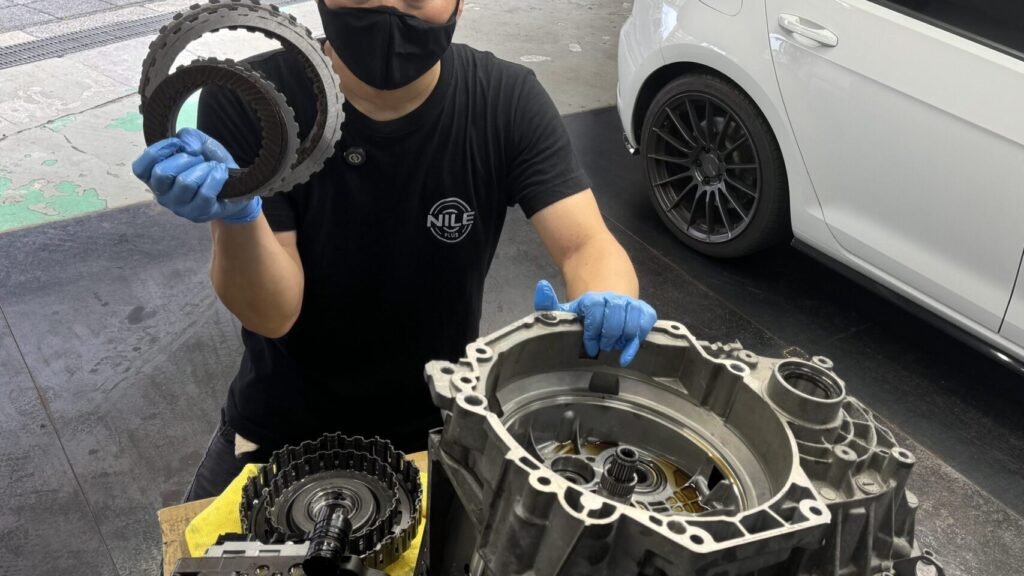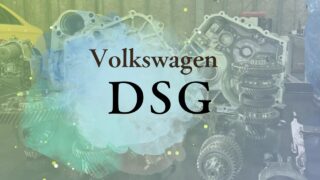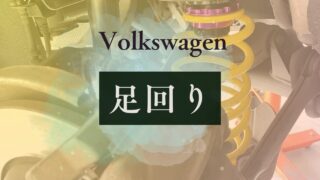How the clutches, mechatronics, and pump work—and key service tips
Volkswagen’s 6-speed wet DSG (code: DQ250) is the dual-clutch transmission used on many higher-output models such as the Golf GTI and Audi TT.
Inside, two hydraulically controlled clutch packs and a mechatronics unit work in tight coordination to deliver lightning-fast shifts and high transmission efficiency.
This guide walks through the internal layout and operating principles of the wet 6-speed DSG—how it differs from the dry type, how the clutch packs are built, what makes its oil pump special, and the service points VW owners should know.
Reference: Nile Mecha Channel “Wet 6-speed DSG teardown overview”
If you’re new to DSG, start here for context:
👉 DSG Basics — Dry vs Wet, how to reduce judder, fluid changes, and mechatronics repair overview
What the Wet 6-Speed DSG (DQ250) Is

The “other” DSG that supports high-output models
VW’s 6-speed wet DSG (DQ250) appears on torque-rich models—Golf GTI/Golf R, Passat, Audi TT, etc. Although it’s still a DCT like the well-known dry 7-speed (DQ200), its design and behavior are different: it’s engineered to reliably handle more torque.
As the name suggests, the clutches run immersed in dedicated oil, which cools and lubricates the plates. The result is stable performance and durability under heat and load.
Wet vs. dry in a nutshell
One-liner: dry = agility/efficiency; wet = durability/smoothness. The platform and car’s character dictate which is used.
Applications & intent
Typical fitments include:
- Volkswagen Golf 5–7 GTI/R, Passat/CC, Tiguan
- Audi TT (8J), A3 2.0T
- Škoda Octavia RS, etc.
With pre-selection (the next gear is queued), shifts complete in tens of milliseconds with minimal shock. Electronically coordinated hydraulics keep hesitation low—even in spirited driving.
Role of the Mechatronics Unit

The brain where electronics and hydraulics meet
The DQ250’s central module is the mechatronics unit—an integrated ECU (electronics) + valve body (hydraulics) that manages clutch engagement, gear selection, and shift timing.
Unlike a traditional torque-converter AT, DSG relies more heavily on electronic supervision. The mechatronics interprets driver demand and instantly modulates hydraulic pressure to execute the shift.
A key distinction vs. DQ200
DQ250 uses a mechanically driven oil pump (engine-driven). Oil pressure rises the moment the engine starts and remains stable at idle, feeding the clutches and shift forks. The dry DQ200, in contrast, uses an electric pump with tighter capacity limits—fine for efficiency, but less ideal for high torque.
Precision oil-path control with solenoids
Multiple solenoid valves route pressure within the mechatronics. For example, during acceleration, K1 (odd gears) is driving while K2 (even gears) has the next ratio staged—this is DSG’s signature pre-selection behavior.
ECU integration & immobilizer on MQB
The mechatronics houses its own ECU with shift maps and hydraulic logic and continuously communicates with the engine ECU. On MQB (Golf 7→) the mechatronics ECU links to the immobilizer. Swapping in a used unit without proper data adaptation will not work.
Bottom line: hardware alone won’t fix behavior—software/data must match.
Clutch Architecture: K1 / K2

What “dual clutch” really means
DQ250 has two clutch packs, K1 and K2. One drives while the other queues the next gear, so torque delivery doesn’t drop during a shift.
Roles and layout (co-axial)
| Clutch | Gears handled | Relative size | Primary role |
|---|---|---|---|
| K1 | 1st / 3rd / 5th | Larger | Main clutch (outer) |
| K2 | 2nd / 4th / 6th | Smaller | Secondary (inner) |
Both are multi-plate packs. Hydraulic pressure squeezes friction plates and steels to transmit torque; releasing pressure opens the pack. The mechatronics meters pressure exquisitely to create DSG’s smooth, fast feel.
Sizing & feel
- K1: larger diameter / more plates → handles low-to-mid-speed, high torque.
- K2: smaller stack → favors higher-gear engagement and light-load smoothness.
Wear evaluation: look for launch slip, longer partial-engagement, or timing lag; check DSG oil condition. Regular fluid service plus adaptation resets helps slow wear progression.
Oil Pump & Hydraulic Circuits
Hydraulic pressure is DSG’s “lifeblood”
Everything inside the DQ250—clutch force, fork movement, solenoid action—depends on stable hydraulic pressure.
Mechanical pump mechanics
Driven by engine rotation, the mechanical pump builds pressure as soon as the engine starts. This supports consistent shift timing even at idle.
Precision is critical; pump wear (gears/shaft) can reduce pressure or, in severe cases, cause shaft failure.
Oil paths, solenoids, and temperature
Pump output is distributed through oil galleries inside the mechatronics. Solenoids open/close paths on ECU command. Temperature and viscosity affect response—cold oil feels heavy; extreme heat lowers effective pressure. Hence, oil quality is critical.
Service interval reality
Factory guidance often cites ~60,000 km fluid changes; many specialists in Japan recommend ~40,000 km due to congestion and climate. Short-trip stop-and-go is harsher on fluid than long highway runs.
If neglected: pressure rise slows, launch feel degrades, shift shock grows. Debris can reach fine passages and solenoids, triggering faults.
Benefits after a proper service: smoother take-up, reduced shocks, crisper response, lower operating temps. Best practice is temperature-controlled filling plus post-service adaptation.
Related reads:
- DSG fluid service — timing and benefits explained
- Costs & effects of 7-speed wet DSG fluid service
- Is the dry 7-speed really “lifetime fill”?
- Hands-on: servicing the 6-speed wet DSG fluid
What’s Inside the Clutch Packs
Multi-plate fundamentals
Wet multi-plate clutches stack friction plates and steel plates. Oil circulates between them to remove heat, enabling compact torque capacity.
K1 vs K2 detail
Both are multi-plate, but tuned differently:
- K1 sheds oil quickly to lock firmly for strong launches and mid-range pull.
- K2 retains a touch more oil for silky engagement in even gears and at speed.
Friction materials emphasize heat and wear resistance; radial grooves manage oil film and cooling.
Wear indicators
- Increasing launch slip
- Rising shift shock or timing lag
- More metallic content in drained fluid
Judgment is holistic: feel + fluid + mileage inform whether to service, adapt, or overhaul.
Symptoms of Wear or Failure
Catch early warning signs
The DQ250 is robust, but as fluid ages or clutches wear, the precise hydraulic control can go off-spec. Left alone, issues migrate to the mechatronics or gear train.
Typical patterns
| Symptom | Likely cause | Typical remedy |
|---|---|---|
| Shift shock / lag | Pressure drop, clutch wear | Fluid service; clutch overhaul if advanced |
| Launch judder | K1 wear | Clutch pack replacement; adaptation reset |
| Whine/knock in motion | Bearing wear, low level | Leak check; mechatronics inspection |
| Delayed D engagement / no R | Solenoid faults | Mechatronics rebuild or replacement |
Note: what feels like a “clutch issue” may be hydraulic or solenoid control. Proper diagnosis uses a scan tool to check pressure values and learned data.
Clutch wear
Most commonly K1. Repeated launches, heavy traffic, and hill starts accelerate wear. Light cases often improve with fluid + adaptation; advanced cases need a clutch pack.
Hydraulic/Fluid problems
Low/aged fluid → foaming/cavitation, unstable pressure, shocks/hesitation. Minor gasket/O-ring seepage around the mechatronics can also degrade pressure—repairs and adaptation often restore behavior.
Mechatronics (electromagnetic) faults
Aging solenoids can cause no-R, flashing D, etc. Targeted testing identifies the culprit; then rebuild or replace the mechatronics.
👉 We visited TOY’s, a professional shop for European transmission repairs
👉 Driveline/Transmission Troubles — DSG, clutch, costs & fixes (hub)
Why Fluid Service Matters
The oil does three jobs
In the DQ250, the fluid is not “just lubricant.” It’s also the coolant and the hydraulic medium:
- Lubrication — reduces friction in clutches/gears/pump
- Cooling — sheds heat from launches and shifts
- Pressure transmission — applies clutch force and moves forks
When fluid degrades, you’ll feel slip, shock, and delays.
Interval: book vs. reality
VW documentation: ~60,000 km.
Specialist practice in Japan: ~40,000 km (congestion + climate accelerate aging).
What improves after service
Shops typically manage fill temperature with a scan tool and reset clutch adaptations to realize the full benefit.
Don’t defer it: once degraded, the oil can’t cool or transmit pressure correctly, and it accelerates wear everywhere else. Treat fluid changes as preventive maintenance, not a band-aid.
Related reads:
- DSG fluid service — timing and benefits explained
- Costs & effects of 7-speed wet DSG fluid service
- Is the dry 7-speed really “lifetime fill”?
- Hands-on: servicing the 6-speed wet DSG fluid
FAQ
Q1. How do wet (DQ250) and dry (DQ200) DSGs differ?
Cooling. Wet = clutch immersed in oil → heat-resistant, higher torque capacity. Dry = no clutch oil → lighter and more efficient, but more heat-sensitive during launches/traffic.
Q2. Should I really change DSG oil around 40,000 km?
Yes, in many Japanese use cases. The manual often says ~60,000 km, but heat/humidity and stop-and-go accelerate aging. Early service preserves cooling and hydraulic control.
Q3. Can the mechatronics be repaired?
It depends. Solenoid/gasket issues are often rebuildable; ECU/pump failures may require replacement. New is pricey (~¥300k class), while quality rebuilds are typically ½–⅔ the cost.
Q4. Is judder always the clutch?
Not always. Fluid condition, hydraulic control, and even engine ignition issues can contribute. If judder appears mainly at idle/launch, check fluid/adaptations and engine health, not just the clutch.
Q5. DIY fluid or clutch service?
Not recommended. Correct oil temperature, scan-tool procedures, and torque/angle specs are essential. Mistakes risk hydraulic faults or clutch damage.
Q6. Can a simple fluid service reduce shift shock?
Often yes—if degraded fluid is the cause. Pair the service with post-service adaptation for best results.
Q7. What’s the typical lifespan of a DQ250?
Highly usage-dependent, but 100,000–150,000 km without major issues is common with proper maintenance. Heat and neglected fluid shorten life.
Q8. Which should I replace first—mechatronics or clutch?
Rule of thumb: launch slip/harsh take-up → clutch; no gear engagement/warning lights → mechatronics. Still, perform scan + pressure checks to split causes before deciding.
Notice: This article explains the structure of the 6-speed wet DSG (DQ250). Disassembly and replacement require specialist knowledge and tools. Always have work performed by certified technicians or a VW/Audi specialist.





-1.jpg)
-120x68.jpg)
-2-120x68.jpg)
コメント